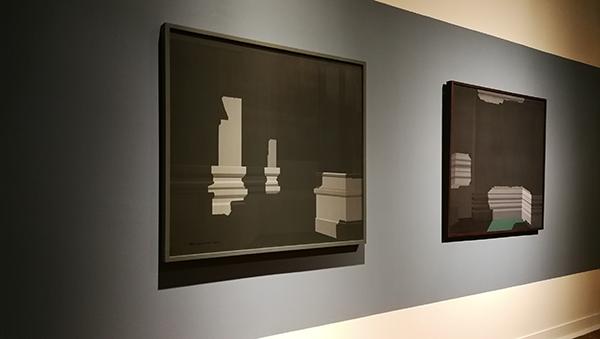นิทรรศการศิลปกรรมสะสมมหาวิทยาลัยศิลปากร ครั้งที่ 3 "Luminous นัยแสง"

นิทรรศการศิลปกรรมสะสมมหาวิทยาลัยศิลปากร ครั้งที่ 3 "Luminous นัยแสง" ผลงานโดย จักรพันธุ์ โปษยกฤต (Chakrabhand Posayakrit), ปรีชา เถาทอง (Preecha Thaothong), สุวิชาญ เถาทอง (Suvichan Thaothong), ผ่อง เซ่งกิ่ง (Phong Sengking), อารยา ราษฎร์จำเริญสุข (Araya Rasdjarmrearnsook) และ อัศนีย์ ชูอรุณ (Asanee Chooarun) จัดแสดงระหว่างวันที่ 4 - 27 มิถุนายน 2561 ณ หอศิลป์มหาวิทยาลัยศิลปากร : Art Centre Silpakorn University
นิทรรศการ Luminous นัยแสง
นิทรรศการศิลปกรรมสะสมมหาวิทยาลัยศิลปากร ครั้งที่ 3
4 - 27 มิถุนายน 2561
ณ ห้องนิทรรศการหลัก หอศิลป์มหาวิทยาลัยศิลปากร วังท่าพระนิทรรศการที่คัดสรรและจัดแสดงโดยหอศิลป์มหาวิทยาลัยศิลปากร เพื่อแสดงถึงพัฒนาการของผลงานศิลปะที่ให้สาระสำคัญต่อ “แสง” ผ่านผลงานของ 6 ศิลปิน ในคลังสะสมของมหาวิทยาลัยศิลปากร ได้แก่ จักรพันธุ์ โปษยกฤต ปรีชา เถาทอง สุวิชาญ เถาทอง ผ่อง เซ่งกิ่ง อารยา ราษฎร์จำเริญสุข และ อัศนีย์ ชูอรุณ
ชมนิทรรศการและทำความเข้าใจกับแสงรอบตัวเราที่มีผลต่อการสร้างสรรค์ ผ่านการสังเกตแสง เงา และสีของแสง ไปพร้อมกับเรียนรู้เส้นทางประวัติศาสตร์ศิลปะของในห้องกิจกรรมการเรียนรู้
...................
แสงคือชีวิต คือการดำรงอยู่ แสงคือความหวัง แสงคือพรจากฟากฟ้า แสงจะดำรงอยู่ต่อไปไม่หนีหายแม้จะมีวิวัฒนาการที่แปรเปลี่ยน
แสง คือ สิ่งที่ไร้ซึ่งการจับต้องทางกายภาพ เราเห็นแสงได้ก็ต่อเมื่อมีรูป (วัตถุ) มาแทรกระหว่างกลาง เมื่อแสงกระทบวัตถุที่ทึบ จึงเกิดเป็นเงา แสงและเงากลายเป็นคู่ตรงข้าม ราวกับมีขาวมีดำ แสงเดินทางจากแหล่งกำเนิดหลักอย่างดวงอาทิตย์โดยใช้เวลาเฉลี่ยราว 8.3 นาทีจนมาถึงพื้นโลก เป็นสิ่งจำเป็นต่อสรรพสิ่งและหล่อเลี้ยงชีวิตให้ดำรงอยู่ ในอดีตมนุษย์พึ่งพาแหล่งพลังงานแสงแห่งเดียงคือดวงอาทิตย์ เมื่อผ่านกาลเวลาจึงค่อยๆคิดค้นการสร้างแสงในรูปแบบต่างๆ เพื่อการส่องสว่างและดำรงชีพอื่นๆ จนถึงเมื่อวิทยาศาสตร์เข้ามาเติมเต็มความสว่างไสวของมนุษย์ด้วยสิ่งประดิษฐ์ต่างๆ จึงเกิดการคิดค้นแหล่งกำเนิดแสงแหล่งใหม่ขึ้น
ในเส้นทางของประวัติศาสตร์ศิลปะที่เดินทางมาอย่างยาวนาน “แสง” คือสิ่งคู่ขนานที่อยู่คู่มากับการแสดงออกทางศิลปะทุคยุคทุกสมัย แรกเริ่มอาจเป็นเพียงเครื่องช่วยในการมองเห็นวัตถุ เรื่อยมาจนเป็นปัจจัยหลักในการแสดงออกของศิลปะ แสงอาจเป็นปัจจัยเริ่มแรกในการก้าวข้ามยุคสมัย ไม่ว่าจะเป็นการใช้แสงที่ส่องสว่างลงมาจากฟากฟ้าในภาพ เพื่อแสดงออกถึงการดำรงอยู่ของพระเจ้า หรือการเปลี่ยนทิศทางของแสงเพื่อมุ่งให้ความสำคัญกับต่อการเปล่งประกายความเป็นมนุษย์ในยุคต่อมา เรื่อยมาจนถึงยุคสมัยใหม่ที่สามารถจำแนกแสงว่ามิได้เป็นเพียงแค่สีเดียวอีกต่อไป โลกทัศน์ของโลกสมัยใหม่นี้ได้ทำให้เราเห็นแสงในหลากหลายสีสันและหลากหลายมิติ
ในช่วงทศวรรษที่ 2510 ถึง 2520 ในพื้นที่ของการแสดงศิลปกรรมแห่งชาตินับได้ว่าเป็นช่วงเวลารอยต่อแห่งการเปลี่ยนผ่านยุคสมัยของผลงานศิลปะในประเทศไทย โดยในช่วงต้นทศวรรษที่ 2510 ความเป็นนามธรรมได้เข้ามากระทบพื้นที่สร้างสรรค์ดังกล่าวและเรื่อยมา จนถึงต้นทศวรรษที่ 2520 ที่ผลงานได้พัฒนาจนเป็นการใช้วัสดุผสม/จัดวาง แต่ที่น่าสนใจคือ ยังมีผลงานอีกจำนวนหนึ่งที่ยังคงสร้างสรรค์ผลงานในแนวทางเหมือนจริง และให้ความสำคัญต่อทักษะฝีมือและทัศนธาตุที่เฉียบคม โดยในช่วงเวลาประมาณ 10 ปีนั้น เราได้เห็นการใช้แสงในการสร้างสรรค์ผลงานศิลปะได้อย่างน่าสนใจ
จาก “แสง” ที่เป็นปัจจัยต่อการส่องสว่างต่อวัตถุและส่งผลให้เกิดภาวะของภาพเหมือนจริง เรื่อยมาจนสู่การตัดทอนรูปทรงด้วยการใช้แสง ผลงานของศิลปินทั้ง 6 เป็นเพียงตัวอย่างงานบางส่วนที่คัดสรรมาเพื่อให้เห็นภาพความเป็นไปของแสง ที่ได้สาดส่องผลงานศิลปกรรมแห่งชาติเรื่อยมาตั้งแต่อดีต
.................................
นิทรรศการนี้อยู่ภายใต้โครงการศิลปกรรมสะสมมหาวิทยาลัยศิลปากร ซึ่งหอศิลป์มหาวิทยาลัยศิลปากรได้คัดสรรผลงานจากคลังสะสมของมหาวิทยาลัย มาจัดแสดงเพื่อกระตุ้นการเรียนรู้และเสริมความเข้าใจในศิลปะผ่านหัวเรื่องต่างๆ ผลงานในคลังสะสมนี้ล้วนเป็นผลงานที่ได้รับรางวัลจากการประกวดศิลปกรรมระดับชาติ ในการแสดงศิลปกรรมแห่งชาติและศิลปกรรมร่วมสมัยของศิลปินรุ่นเยาว์ ซึ่งถือเป็นเวทีหลักของพัฒนาการสร้างสรรค์ศิลปกรรมในวงการศิลปะของไทย
Luminous นัยแสง Exhibition
The Art Collection of Silpakorn University ๐ season 3
4 - 27 June 2018
at Main Exhibition Hall of the Art Centre, Silpakorn University (Wangthapra)The Art Centre, Silpakorn University proudly presents “นัยแสง Luminous” exhibition to illustrate the development of artworks that gives an importance upon “light”. The exhibition showcases works from 6 leading artists from Silpakorn University Art Collections, namely Chakrabhand Posayakrit, Preecha Thaothong, Suvichan Thaothong, Phong Sengking, Araya Rasdjarmrearnsook and Asanee Chooarun.
Visit the exhibition and understand about the light that affects art creation, together with learning about the timeline of Thai art history in Play + Learn rooms.
...................
Light is life, life is existence, light is hope, light is a gift from the sky, light will be always with us no matter how the world changes.
Light can’t be physically touched. We can see light when there are objects in between. When it shines on an opaque object, a shadow is made. Light and shadow become opposite sides, as white exists, so does black. Light comes from the source like the sun. It takes around 8.3 minutes to travel to earth. Light is essential to living things on earth and is the origin of lives. In the past, humans originally relied only on the sun, as a major source of light. Over the course of history, they gradually found and invented various ways to create different light sources. Until science has played a big role, illuminating humans with various inventions, several lighting and light sources were then invented.
On the long path of the history of art, “light” has always been within. Light is one of the main factors that has been staying with the changes of expressions of art in all ages. Initially it might just be a tool to help us see objects, but later on it has become the main aspect in art expression. Light might be the original factor of crossing different ages of art, whether it shines from the sky to express the status of God upon the darkness or focuses on the symbolical brightness of humanity in later age. Until these days, light is not only in one colour anymore. The modern world has lead us to see light in various colours and dimensions.
Between 1967 and 1977, in the scope of the National Exhibition of Art, it can be considered a transitional period of art expression in Thailand. In the beginning of 1967, abstract art came into effect up until the beginning of 1977 with the use of mix-media/installations. Nevertheless, there also were other works that represent realistic visual appearance that gave an emphasis on artistic skills and sharp visual elements. Within those ten years, we can see how light were interestingly used in the art works.
From where “light” was used as illuminating factor on objects to create realistic works, to the reduction of form with the use of light; works of these renowned artists are only a part of the entire works to show how light has been shining over the artworks of National Exhibition of Art from the old days.
.................................
This exhibition is curated under the Art Collection of Silpakorn University project by the Art Centre, Silpakorn University to enhance the learning and understanding of art in different topics. All works from the university’s collection are award-winning works from the National Exhibition of Art and the Exhibition of Contemporary Art by Young Artists, which are the major art competitions of Thailand.
ข่าวประชาสัมพันธ์ : หอศิลป์มหาวิทยาลัยศิลปากร : Art Centre Silpakorn University



